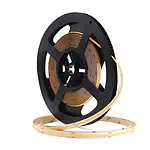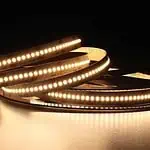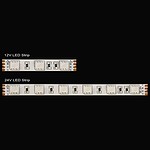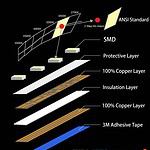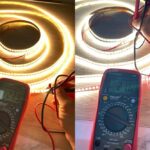LED strips are voltage sensitive, so whether you are lighting up commercial or residential space, voltage is a crucial factor to consider. And that is why you must know the differences between low-voltage and high-voltage LED strips and their application.
Low-voltage LED strips are suitable for residential and indoor lighting. They are highly energy efficient and safe to use. The minimal cutting mark length of these strips makes them the best option for DIY projects. In contrast, high-voltage LED strips are excellent for commercial and industrial lighting. The long run and continuous brightness of this fixture are preferable for large installations and outdoor projects. However, as they deal with direct line voltage, you must get help from professional electrical to install these fixtures.
There are a lot more differences to explore between low-voltage and high-voltage LED strips, so let’s begin-
What Are Low Voltage LED Strip Lights?
Low-voltage LED strip lights refer to the ones that operate at minimum voltage rates. Usually, DC12V and DC24V LED strips are known as low-voltage LED strips. Besides, 5-volt strip lights are also available. You can use them for under cabinet lighting, bedroom lighting, bathroom lighting, and more. However, these strips require a driver to convert the standard household voltage ((110-120V) to low voltage.
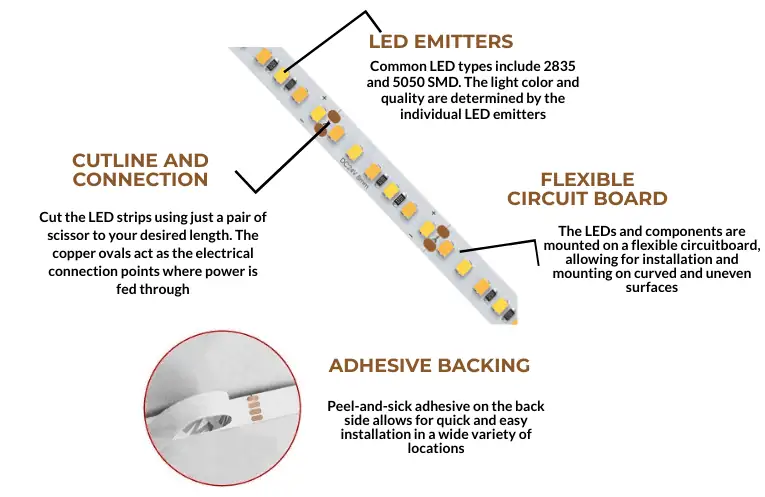
Features
Besides operating at a lower voltage, there are some basic features of low-voltage eLED strips that you must know. These are as follows-
Best for indoor Lighting: Low voltage lights are preferable for indoor Lighting, so most residential lights are of a lower volt. One of the most popular applications of low-voltage LED strips is cove lighting. You will find these types of Lighting in most new interior houses with modern taste.
Safe to use and install: As these light fixtures operate at low voltage, they are safe to install. You can handle the wiring and mount them to your space without any professional help.
Energy efficiency: Another prominent reason why low voltage LED strip light is famous is its energy-efficient feature. They consume much less energy than the high-voltage strips. Thus, you can save your monthly cost on electricity bills.
Low heat emission: Low voltage LED strip lights produce minimal heat. So, you won’t need to have frequent replacement as overheating can damage lights. And most importantly, you can touch this light fixture without worrying that it will burn your hands.
Pros & Cons
| Pros | Cons |
| Generate little heat Energy efficient Safe and suitable for residential lighting Dimmable No UV emission Environmental friendly | May need transformer Lower brightness than high voltage lights May not be a good choice for commercial needs |
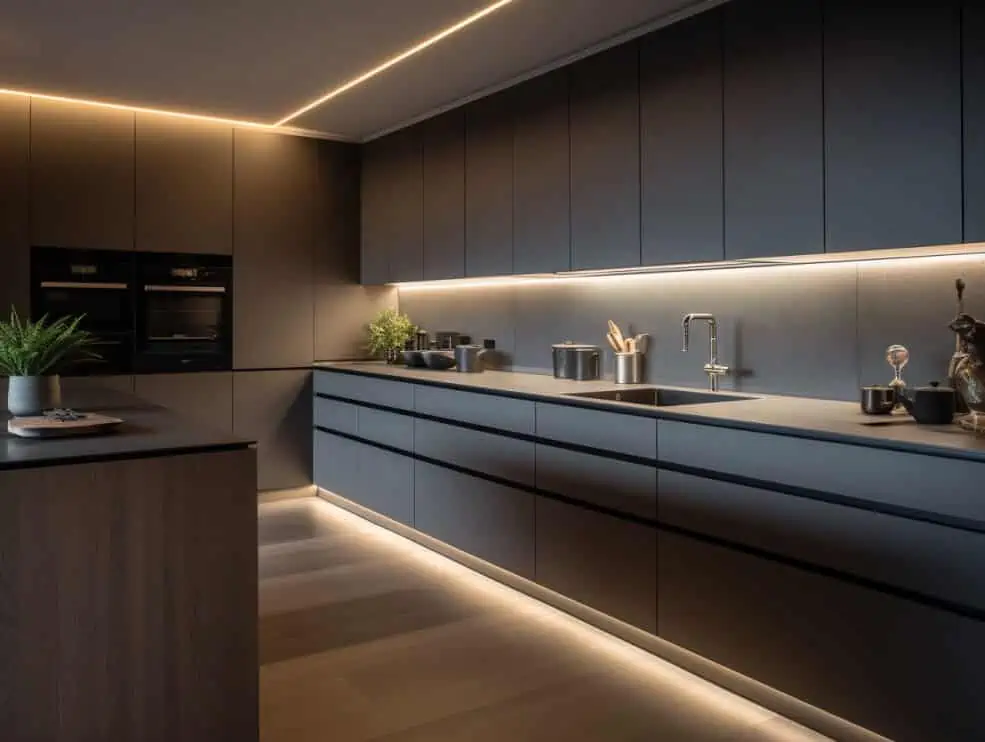
When & Why Use Low-Voltage LED Strip?
When you need energy-efficient, safe, and indoor Lighting, low-voltage LED strips are best. They are used for multiple applications. The most common uses of these fixtures are in residential areas. Besides, they are used in cars, decorative settings, and more. Here are some of the uses of low-voltage LED strips:
Vehicle lighting: The lower energy consumption feature of LED strip lights makes them suitable for vehicle lighting. Besides, these LEDs last for about 50,000 hours, so you need not worry about the durability of the Lighting of the car. Low-voltage LED strip lights are mostly used under the seats and below the car to create a mesmerizing floating effect. In this case, 12-volt strip lights are the most popular choice; you will find them in most RV cars. To learn more, check this- The Complete Guide to 12 Volt LED Lights for RVs.
Staircase lighting: As low-voltage LED strip lights don’t get hot, you can even use them on the railings of your stairs. You will find them on the stair lighting of modern duplex houses or other indoor stairs. The flexibility and cutting feature of LED strip lights allows you to fit these fixtures even on the corner of the stairs with ease. For more stair lighting ideas, check this- 16 Stair Lighting Ideas With LED Strip Lights.
Under-cabinet Lighting: Whether it is your bedroom, closet, or kitchen cabinet, low-voltage LED strips are best to fit your under cabinets. However, you must consider the color temperature, CRI, and the material of your cabinet before choosing the right fixture. This guide will help you in finding the best strip- How To Choose the LED Strip Lights For Kitchen Cabinets?
Bedroom, kitchen, & bathroom lighting: As I already mentioned, low-voltage LED strips are a popular choice for residential Lighting. You can use them in your bedroom, bathroom, living room, or kitchen. They are excellent for both general and accent Lighting. You can also use low-voltage LED strips as task lighting by adding them under cabinets.
DIY projects: Low voltage LED strips are safe for experimenting or conducting DIY lighting projects. They are flexible and resizable. So, you can cut them to your desired size using a scissor. Besides, the installation of LED strips is very easy. Simply remove the adhesive backing and press it to the surface. Thus, you can go for creative lighting ideas; check this for DIY mirror lighting- How To DIY LED Light Strips For Mirror?
What Are High-Voltage LED Strip Lights?
High-voltage LED strip lights operate at the standard household or commercial voltage level of 110-120 volts. (Note: for some countries, this voltage rating can be 220-240 volts.) High-voltage LED strips don’t require any driver; they can work directly with the electrical grid voltage. Besides, they are brighter than low-voltage LED strips. All these make them more suitable for commercial Lighting.
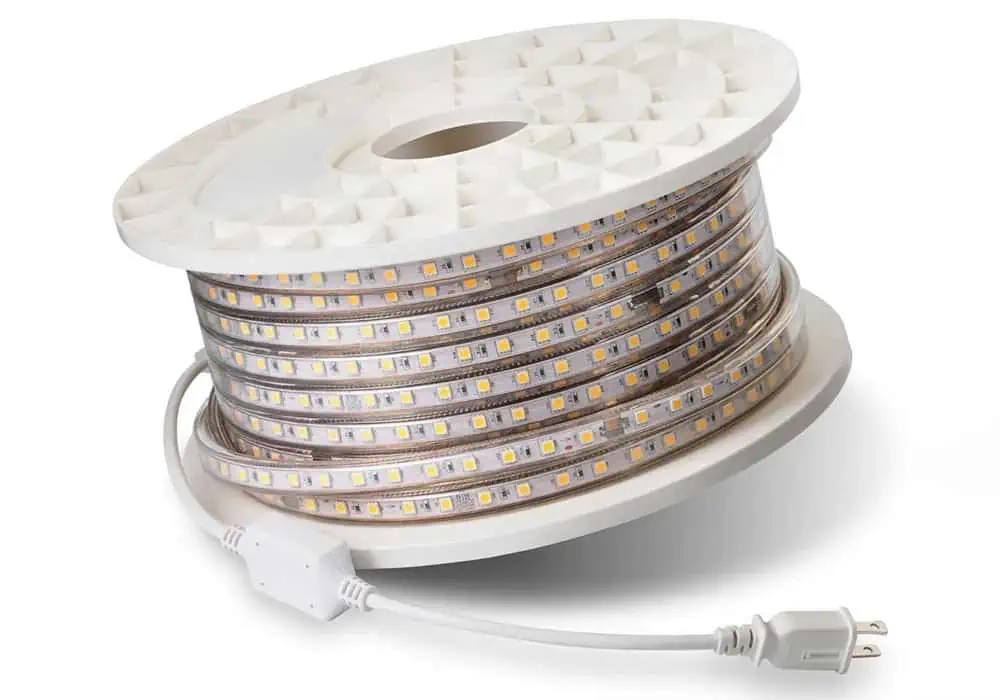
Features
Here are some significant features of high-voltage LED strips that differentiate it from low-voltage ones-
Direct Line Voltage Operation: The prime feature of high-voltage LED strips is that they don’t require any transformer or driver. These fixtures match the voltage of the direct line; this is what distinguishes them from low-voltage lights.
Long Runs: You can use high-voltage LED strips for long runs without facing voltage drop issues. This makes them suitable for large installation projects in commercial areas. It doesn’t need multiple strip joining hassles as they come in longer lengths.
Durability: As high-voltage LED strips are designed for commercial usage, they have a robust structure. Most of them come with standard IK and IP ratings to withstand physical contact or natural calamity. Besides, they last much longer than traditional Lighting.
High Wattage Option: High voltage LED strips offer more wattage options. That is, they can handle higher power LEDs per meter compared to low-voltage LED strips. This makes them brighter and suitable for commercial and outdoor Lighting.
Professional Installation: Due to high voltage ratings, it is not safe for the newbies to try installing these strips by themselves as there is a possible life risk. So, you must hire a professional electrician to set up these lights.
Pros & Cons
| Pros | Cons |
| High brightness Minimal voltage drop issues No driver or transformer is required Reduced wiring complexity Long runs Ideal for commercial and outdoor spaces | Needs professional installation Less Versatile for DIY Flickering issues Consumes more energy than low voltage ones |
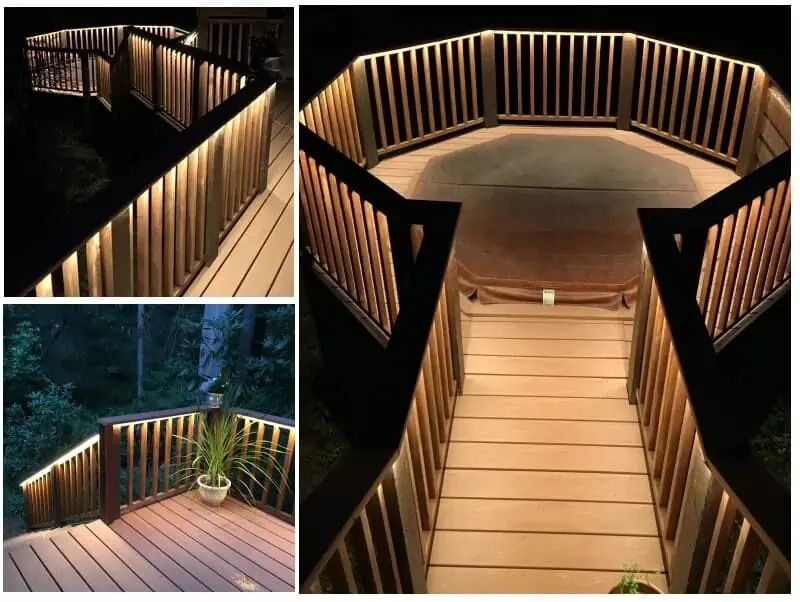
When & Why Use High-Voltage LED Strip?
High-voltage LED strip lights are installed in places that require continuous bright lights. These fixtures are ideal for commercial and industrial areas. The most common applications of these fixtures are as follows-
Hotel and Restaurants: Active and crowded places like restaurants and hotels need bright fixtures with adequate brightness. And for these reasons, high-voltage LED strip lights are used in these areas. Besides outdoor Lighting, these fixtures are also used in the interior lobbies, hallways, and corridors.
Outdoor Signage: Brightness is the most prominent factor to consider when choosing light fixtures for outdoor signage. As high-voltage LED strips produce brighter illumination than low-voltage ones, they work excellently for signage. Besides, high-voltage LED strips and LED neon flex are popular options for outdoor signage.
Industrial Lighting: High-voltage LED lights are ideal for big industrial lighting. These lights are of higher IP and IK ratings that resist the unbearable environment of production factories. To know more about industrial lighting, check this- A Comprehensive Guide To Industrial Lighting.
Commercial Spaces: Locations like museums, hospitals, offices, and other commercial spaces use high-voltage LED strips for outdoors. Besides, these lights are also used in other public spaces like parks, facades, pathways, and landscapes. To learn more, check this: Commercial Lighting: A Definitive Guide.
Low Voltage Vs. High Voltage LED Strips: The Differences
Check out the differences between low-voltage and high-voltage LED strips to decide which one is ideal for your project-
Appearance
High-voltage LED strips have a clean, transparent appearance with high transparency. This makes them suitable for various indoor and outdoor lighting applications. Yet, the low-quality ones can show a grayish-yellow appearance. Typically, a flexible PCB board is sandwiched between two primary conductors to create these LED strips. The main power source for the entire strip is provided by one independent wire on each side, which may be an alloy wire or a copper wire. High-voltage AC power travels down these main conductors.
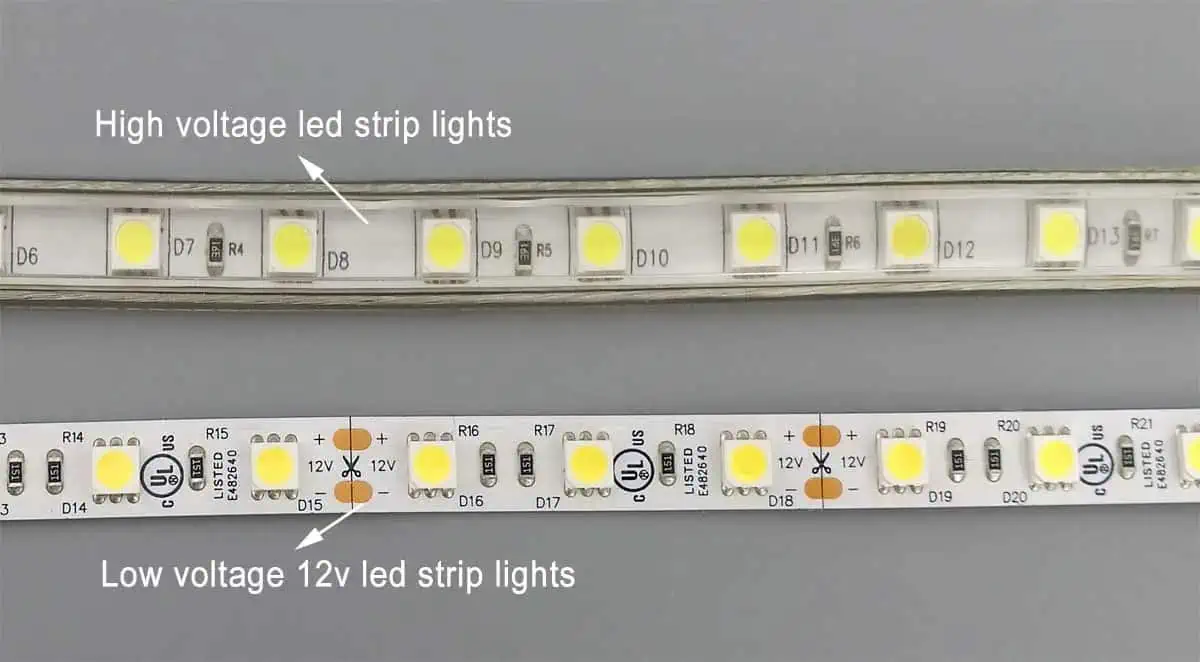
In contrast, the low-voltage LED strips have some differences in appearance in comparison to the high-voltage ones. They do not have double-alloy wires on either side. As they operate on low voltage, the two main power lines for these strips are directly integrated into the flexible PCB.
LED Strip Running Length
Voltage drop is a major concern when talking about LED strip lengths. As the length increases, the voltage drop also intensifies. As a result, the brightness of the lights gradually starts to dim as you increase the strip lengths. For low voltage LED strips of 5V to 24V range, a maximum length of 15m to 20m works okay. As you increase the length more than this, the voltage issues can be significant. To solve this, you will need to take extra measures that will make the wiring complex and increase the installation cost, too.
In contrast, high-voltage LED strips are longer in length. They can be 50 meters or as long as 100 meters! Due to their long length, they don’t usually face voltage dropage issues. The brightness remains constant throughout the length. So, if you need a large installation, high-voltage LED strips are more favorable than low-voltage LED strips. To know more about LED strip lengths, check this- What Are the Longest LED Strip Lights?
Safety
The operating voltage of high-voltage LED strip lights can be as high as 240V. Such high-rated voltage is not safe to work with as there are possible chances of accidents. In contrast, low-voltage LED strips run at minimal voltage, 12V or 24V. These fixtures are safe to use, and anyone can install them with any professional help.
Flickering Issues
A dedicated power driver usually powers high-voltage LED strips. It uses a rectifier bridge to convert AC voltage (e.g., 110V/120V/230V/240V) to the DC voltage required to operate the LEDs. However, the problem is that some inexpensive power drivers may not effectively filter or regulate the incoming AC voltage. As a result, it leads to variations in the output voltage, causing the LEDs to flicker or strobe rapidly. To clear this up, you must know about the cycle of electrons that makes these lights glow.
One Hertz or Hz indicates one complete cycle of electrons per second. The light turns off two timers in every cycle or 1 Hz. That means as the electricity operates in 50 Hz and 60 Hz (for the US), the LED lights turn on and off 100 to 120 times in one second. This goes so fast that human eyes can’t catch it. But if you record or turn on the camera, you will see the flickering issues with high-voltage LED strips.
So, here, you get a plus point using low-voltage LED strip lights. These strips are powered by stable direct current (DC) voltage. These provide constant lighting output and don’t have the same fluctuations as alternating current (AC).
Packaging
High voltage LED strips come in 50 meters to 100 meters per role. So, you will get a big package of products ideal for large installations. In contrast, low-voltage LED strips come in rolls of 5 to 10 meters and are ideal for small projects. However, you must consider that going over 10 meters can cause voltage drop issues. In this case, you will need to add additional wirings to keep up the light output.
Application
High-voltage LED strip lights are best for outdoors, and low-voltage ones are for indoors. You should choose low-voltage LED strips for your bedroom, kitchen, bathroom, or other residential spaces. Again, in vehicle lighting, low-voltage LED strips are used. In contrast, the intense brightness of the high-voltage LED strips makes them ideal for commercial and industrial uses. Besides, these fixtures have higher IK and IP ratings, so they fit the requirements for these locations.
Waterproof Or IP grade
The high-voltage LED strips are used mostly for outdoor uses. And so, they go through extreme weather conditions like rain, wind, dust, storms, etc. A higher IP rating is essential to ensure the LED strip withstands such weather conditions. High-voltage LED strips have an IP rating of IP65, IP67, or even IP68. This makes them ideal to face the adverse environment of the outdoors. On the other hand, low-voltage LED strips are mostly used for indoor applications and come at low IP ratings. Lower IP ratings like IP20 might be sufficient in residential lighting. Nevertheless, they can be of higher ratings, too; you must get one considering the contact of water with the fixture. Based on this, you can opt for an epoxy dustproof LED striped of IP54 or IP65 for casing rainproof, casing filling for IP67.
However, for fully submerged installation, purchase one with IP68. There are many LED strip manufacturers that offer you customizable IP ratings; you can contact them and get a suitable strip for your project. Check this to get connected to the top LED strip manufacturers- Top 10 LED Strip Light Manufacturers And Suppliers in WORLD.
LED Strip Cutting Unit
The high-voltage LED strips of 110V-240V usually come with a cut length of 10 cm, 50cm, or 100cm. They have scissors marks every certain distance apart, indicating that this is the place where you can cut it. You cannot cut the strip light anywhere apart from the markings. If you do, the entire set of LED strip lights will not function.
Low-voltage LED strip lights have more frequent cut marks than high-voltage ones. They can be 5 cm to 10 cm apart. Such a small distance between the adjacent cut marks makes these strips more flexible for accurate sizing and creative projects.
Installation
Although I suggest you get assistance from a professional for high-voltage LED strip installation, it is simpler than the low-voltage ones. Usually, the low-voltage ones come with shorter lengths, and you need to join multiple strips to increase the length. This can result in a voltage drop. To solve this issue, you need to join parallel wiring from each joining section to the power source. Thus, as you increase the length with low-voltage LED strips, the procedure becomes more complex. Apart from all these, you need a driver to connect with the strips. The function of this driver is to minimize the voltage of the direct power source and supply it to the low-voltage LED strips. All these facts make the installation of low-voltage LED strips challenging for big projects. But you won’t face this issue with high-voltage LED strips as they can operate on direct line voltage.
Lifetime
Due to running on higher voltage rates, the internal components of high voltage rates go through more stress. As a result, they generally tend to have a shorter life span of around 10,000 hours, which is much shorter than the low-voltage LED strips. Besides, the guarantee provided by the manufacture of high-voltage LEDs is also limited. But the ones with low voltage have extended lifetime; they can last for 30,000 to 70,000 hours or more. And you will also get a warranty of 3 to 5 years or more from these strips.
Price
The upfront cost of low-voltage and high-voltage LED strips is similar. But the overall price of high voltage lines can be a bit cheaper as they support longer installations with a single power supply. However, for large installations with low-voltage LED strips, you will require multiple power supplies. This will increase the overall cost. However, in terms of energy consumption, high-voltage LED strips use more energy, so you will need to spend more on electricity bills. In this case, using low-voltage LED strips can be cost-effective in the long run.
| Low Voltage Vs. High Voltage LED Strips: Quick Differentiating Chart | ||
| Criteria | Low-Voltage LED Strip | High-Voltage LED Strip |
| Working Voltage | DC12V or DC24V | 110V-120V or 220V-240V |
| Maximum Running Length | 15-20 meters (approx) | 50 m but can go up to 100 m (max length) |
| Voltage Drop | More prone to voltage drop as you increase the length | No severe voltage issues |
| Cut mark length | 5 cm to 10 cm | 10 cm, 50cm, or 100cm |
| Flickering Issues | No | Yes |
| IP rating | Available in both low and higher IPs | Usually, high IP ratings ranging from IP65 to IP68 |
| Application | Used for indoor lighting and residential areas | Best for outdoor lighting and is ideal for commercial and industrial areas |
| Packaging | 5m to 10m per reel | 50m or 100m per reel |
| Lifetime | 30,000 to 70,000 hours or more | 10,000 hours |
| Power Consumption | Low | Higher than low-voltage LED strips but much less than other traditional lighting like incandescent or fluorescent |
| Brightness | Lower brightness than high voltage strips | Brighter than the low-voltage ones |
| Installation | Easier to install without extensive electrical knowledge or professional help | Requires professional electrician |
| Safety | Safer voltage rating | Potential safety hazard |
| Voltage Variation | More resistant to voltage variation | Robust but not equally resistant to changes in voltage |
Considerations For Choosing Low Voltage Vs. High Voltage LED Strips
Before choosing between low and high-voltage LED strips, here are the factors you must consider-
Location
Firstly, consider if you are looking for indoor lighting or outdoor lighting. Usually, for indoor lighting, low-voltage LED strips are preferable, and high-voltage pens for outdoors. Besides, for commercial and industrial locations, low-voltage strips are not suitable. In this case, you must use high-voltage strips. But if you are lighting for residential areas, low-voltage LED strips are a safer option.
Lighting Project Scale
For large-scale projects, high-voltage LED strips are the best option. This strip light comes with long-length reels, and you won’t face voltage issues covering large areas. In this case, if you use low-voltage strips, it will require multiple power sources to fix voltage drops. This will make the installation critical. So, always go for high-voltage LED strips for big-scale projects. However, if you need LED strips for small areas like bedroom or kitchen lighting, low-voltage LED strips are okay.
Cost
Before coming directly to cost, remember high voltage LED strips consume more energy. So, using this energy, you will need to spend more on electricity bills compared to the low voltage ones. Besides, the price of high voltage LED strips is as they come in large reels. But overall, the upfront cost is similar. Yet, for long installation, installing low-voltage LED strips will be expensive as you will need multiple power supplies.
Dimming Compatibility
High-voltage LED strips mostly use Phase-cut (triac) dimmers. These are often used for residential and commercial applications where high-voltage AC power is readily available. Low-voltage LED strips, on the other hand, have a wider range of dimming options. This includes – DALI (Digital Addressable Lighting Interface) control, 0–10V analog dimming, and PWM (Pulse Width Modulation) dimming. However, the choice of dimming method depends on the specific LED strip and driver used.
Voltage Drop
When choosing low-voltage LED strips for large installations, keep in mind that as you increase the length, the voltage drop will increase. In such a situation, the light will begin to lose its brightness as it runs away from the power source. This will result in uneven Lighting. However, by increasing the voltage of the strips, the issue with voltage drop can be minimized. That is, high-voltage LED strips are a good choice to avoid voltage drop issues. But, if you intend to purchase a low-voltage LED strip, going for 24 volts is a better choice than 12 volts for extended length. Yet, follow this guide to learn more- How to Choose The Voltage of LED Strip? 12V or 24V?
Additionally, to make precise calculations and ensure optimal brightness throughout your installation, we recommend using our Voltage Drop Calculator. This tool helps you determine the best setup by calculating the expected voltage drop based on your specific project requirements. It’s a straightforward way to achieve balanced, consistent lighting.
Color Temperature & Color
Color temperature determines the color of light or its hue. Going for a higher color temperature will give you a bluish, cool tone light. And if you want warm Lighting, choose LED strips with low color temperature. However, both low-voltage and high-voltage LED strips are available in different color variations. You can choose RGB LED strips if you want colorful lighting options. For white lights, tunable LED strips are the best option for its CCT adjustable feature. To learn more about color temperature, check this- How to Choose LED Strip Color Temperature?
Brightness, LED Density, & SMD
High-voltage LED strips have more prominent brightness. So, if you need brighter lights outdoors, these are the best options. However, the LED density and size of the LED chip or SMD play a crucial role here. High-density LED strips are brighter than low-density ones. So, whatever voltage you choose, consider the density to get your desired brightness. However, if you are facing brightness issues with your existing LED strips, check this- How To Make LED Strip Lights Brighter?
Ease of Installation
For regular installation or small projects, low-voltage LED strips are easy to install. They use minimal voltage ratings that are safe to install. You won’t need any professional help to mount these LED strips. But when it comes to large installations, working with low-voltage strips becomes difficult as you need to work with parallel wiring to maintain voltage constancy. For this, high-voltage LED strips are easy to install. But as they have a possible life risk to work with high voltage, you will need a professional electrical for the installment. To learn the installation process, check this- How To Install And Use LED Strip Lights?
Energy Efficiency
If you are looking for an energy-efficient option, undoubtedly, a low-voltage LED is what you are looking for. They consume less energy and thus save you electricity bills. In this case, high-voltage LED strips consume more energy than low-voltage lights.
Power Supply
When using high-voltage LED strips, power supply is not a matter of concern as they use the direct line voltage. But for low-voltage LED strips, you will need an LED driver or power supply. You may go for either constant voltage LED drivers or constant current LED drivers. The constant voltage LED strips have a fixed voltage rating of 5V, 12V, 24V, or others. But constant current LED drivers have a maximum voltage or a range of voltages with a fixed amp (A) or milliamp (mA) value. To learn more, check this- Constant Current vs. Constant Voltage LED Drivers: Which Is Right for You?
Flexibility & DIY
Are you looking for a creative DIY project with LED strips? Low-voltage LED strips are the best choice here. They have minimal cutting length, aiding your size and shaping them to your requirements. Thus, these are more DIY-friendly than high-voltage strips.
Common Misconception About LED Strip Voltage
There are some misconceptions about the voltage of LED strips. You must clear this up before purchasing one for your project-
- Higher voltage means brighter light
One of the common misunderstandings about LED strips is that the high-voltage ones are brighter than the low-voltage strips. But in reality, it is not completely true. High-voltage LEDs give more wattage options and offer higher LED density. But if you keep the wattage and density the same, the brightness will be equal for both low and high-voltage strips.
- High-voltage LED strips are not safe
Low-voltage LED strips are considered safer for DIY installations, but high-voltage strips are also safe if you know proper installation. Still, to maintain safety standards, professionals are appointed for high-voltage fixture installation.
- All LED strips are dimmable
You might think all LED strips are dimmable, but this is not true. The ability to dim an LED strip depends on the LED driver and the feature of the strip. Some LED strips may not support dimming, while others require compatible dimmer switches and drivers. However, low-voltage LED strips have more dimming flexibility than the high-voltage ones.
- LED strip voltage affects the color temperature
The voltage of an LED strip does not affect its color temperature. Color temperature is determined by the characteristics of the LED diodes used in the strip. Whether it is a high-voltage strip or low voltage, the color temperature will remain constant.
- High-voltage LED strip lights are not cuttable
Many of you may think that high-voltage LED strips can’t be cut. But the fact is not true; you can cut high-voltage LED strips, but they have higher cutting mark lengths than low-voltage ones. For instance, the distance between two consecutive cut marks is 50 cm or 100 cm, which is much more than low voltage strips. This makes them less flexible for sizing, but still, you can cut them.
- High-voltage LED strips have a longer lifespan
Higher voltage LED strips don’t necessarily mean they can last longer. The lifespan of LED strips depends on several factors, for instance, the quality of the LEDs, maintenance, thermal management, usage pattern, etc. However, to make your strip last longer, always purchase branded strips and look for one with a better heat sink facility. As high-voltage LED strips deal with direct line voltage, thermal management is an essential factor to consider. To know more about this, check this article- LED Heat Sink: What Is It and Why It’s Important?
However, to make this misconception clearer, go through this article- LED Strip Light Internal Schematic and Voltage Information.
FAQs
The electrical power supplied to the LED strip light is determined by voltage. LED strip lights are voltage-sensitive and designed for specific voltage rates. So, if you supply a higher voltage to a low-voltage LED strip, it will overpower the strips and can cause severe accidents. Besides, with the increase in strip length, the voltage drops; this problem is often faced with low-voltage LED strips.
24V is a better option than 12V LED strip lights. This is because 12V strips face more voltage drop issues. As a result, the brightness of the light gradually decreases as the length increases. But this voltage drop issue is minimized with 24V LED strips. Besides, they are generally more energy-efficient for longer installations in comparison to 12V.
Voltage has a great impact on the output of LED strips. As the length of the LED strip increases, the voltage drop also increases. As a result, the brightness of the light throughout the strips doesn’t remain constant. The Lighting begins to dim as it runs away from the power source. Such a phenomenon is common for low-voltage strips. But you can minimize the voltage drop issues and keep the brightness constant with high-voltage LED strips. Besides, with high voltage LED strips, you can also get greater brightness as it has a greater wattage option.
The best voltage for an LED strip depends on its application. For indoor Lighting and DIY projects, low-voltage LED strips of 12V or 24V are ideal. However, if you are looking for outdoor or commercial Lighting, high-voltage LED strips of standard voltage are suggested.
LED strips have specific voltage and current ratings. Increasing the voltage can make the LED brighter to some extent, but crossing the limit will overpower the light and damage it. However, the brightness of the light depends on the wattage. If you keep the wattage the same, increasing the voltage will not make the LED brighter.
LED strips are voltage-sensitive, so you should not run a 24V LED strip on 12V. If you do so, the light output will be too dimmed or not function at all. It also has a chance to damage the internal components of LED strips.
The maximum length of the 12V LED strip is up to 5 meters. As you extend the length beyond this, it will start showing voltage drop issues.
If the voltage is too low, LED strips may not function properly, or the lighting output might be too dim. Besides, you will face light flickering problems and color inaccuracy. It will further reduce the lifespan of the fixture.
Yes, low-voltage lights are preferable indoors. They are safe to use and easy to install. Besides, low-voltage lights consume less energy than the high-voltage ones. Apart from all these, you will also get a better dimming facility in these fixtures.
The Bottom Line
To sum up, if you are lighting for residential space, low-voltage LED strips are what you need. For commercial and industrial installation, you will need high-voltage LED strips. Yet the flickering issue is a major thing to consider when deciding to go for high-voltage LED strips in commercial areas. One of the major drawbacks of high-voltage LED strips is that they cause flickering that is usually invisible to the human eye. But as you open up the camera on the lighting, it will cause flickers. That is why, if your space is photo-friendly or visitors are more likely to take videos, try to use low-voltage strips.
However, you can get both low-voltage and high-voltage LED strips from LEDYi. Our high-voltage LED strip series comes with 50 meters per reel. Besides, we also have a 48V Super Long LED Strip that comes in 60 meters per reel. So, if you need LED strips for large installations, contact us. Nevertheless, the voltage option is also open!
